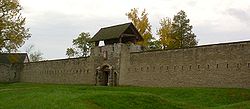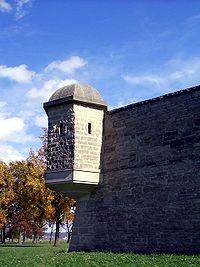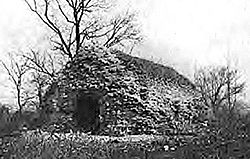- Fort de Chartres
-
Fort de Chartres
 The gatehouse of Fort de Chartres was reconstructed in the 1930s.
The gatehouse of Fort de Chartres was reconstructed in the 1930s.Location: Randolph County, Illinois, USA Nearest city: Prairie du Rocher, Illinois Area: American Bottoms Built: 1720 Architectural style: Colonial French Fortification Governing body: State NRHP Reference#: 66000329[1] Significant dates Added to NRHP: October 15, 1966 Designated NHL: October 09, 1960[2] Fort de Chartres was a French fortification first built in 1720 on the east bank of the Mississippi River in present-day Illinois. The Fort de Chartres name was also applied to the two successive fortifications built nearby during the 18th century in the era of French colonial control over Louisiana and the Illinois Country.
A partial reconstruction of the third and last fort, which was built of local limestone shortly before the end of French rule in the Midwest, is preserved in an Illinois state park four miles (6 km) west of Prairie du Rocher in extreme northwest Randolph County, Illinois. It is south of St. Louis, Missouri. The site and its associated buildings were placed on the National Register of Historic Places and recognized as a National Historic Landmark on October 15, 1966. It is in the floodplain area that became known as the American Bottom.
The name of the original fort honored Louis, duc de Chartres, son of the Regent of France. The fort's stone magazine, which survived the gradual ruin that overtook the rest of the site, is considered the oldest building in the state of Illinois. The state park today hosts several large re-enactments at the fort of colonial-era civil and military life each summer.
Contents
History
The French
On January 1, 1718, the French government granted a trade monopoly to John Law and his Company of the West. Hoping to make a fortune mining precious metals, the company built a fort to protect its interests. The original wooden fort was built in 1718-1720 by a French contingent from New Orleans, led by Pierre Dugué de Boisbriand. When administration of the Illinois Country was moved from Canada to New Orleans, governance was transferred to the Company of the Indies. The fort was built to be the seat of government and to control the Indians of the region, particularly the Fox. The original fort was a palisade of logs with two bastions at opposite corners.
Within five years, flooding from the Mississippi had left the original fort in bad condition. Construction of a second fort further from the river, but still on the flood plain, began in 1725. This fort was also made of logs and had a bastion at each of the four corners. By 1731 the Company of the Indies had gone defunct and returned Louisiana and its government back to the king.
The second wooden fort deteriorated somewhat less rapidly but by 1742 was in bad repair. In 1747 the French garrison moved to the region's primary settlement 18 miles (29 km) to the south at Kaskaskia. The French debated where to rebuild the fort. When rule of the area reverted to the French crown in the 1730s, officials began to discuss construction of a stone fortress. The government in New Orleans wanted to move the garrison permanently to Kaskaskia, but the local commandant argued for a location near the original site.
The government decided to rebuild a fort in stone near the first forts rather than at Kaskakia. Construction began in 1753 and was mostly completed in 1756; however, construction continued at the site for another four years. The limestone fort had walls 15-ft (3 m)-high and 3-ft (1m)-thick, enclosing an area of 4 acres (16,000 m²). The stone for construction was quarried in bluffs about two or three miles (4 km) distant and had to be ferried across a small lake.
The British
In 1763 the Treaty of Paris was signed following the Seven Years War (French and Indian War) and the French transferred control of the Illinois Country to Great Britain. The stone fort had served as center of French administration of the region for only ten years. With the Royal Proclamation of 1763, the British Crown declared almost all of the land between the Appalachian Mountains and the Mississippi River from Florida to Newfoundland an Indian Reserve.
The British had difficulty getting a regiment to their newly acquired fort, but on October 10, 1765, a small detachment of the 42nd Royal Highland Regiment took control of the fort and surrounding area. The 42nd was shortly replaced by the 34th Regiment. French settlers were ordered to leave or get a special license to remain. Many French settlers moved to the more congenial culture of St. Louis.[3][4] The 34th Regiment of Foot renamed the installation Fort Cavendish, after its colonel. However, the post was known as Ft. Chartres from 1768 on, after the 34th were replaced by the18th (Royal Irish) Regiment under the command of Lt. Col. Wilkins. The British, abandoned the post in May 1772 when the majority of the 18th (Royal Irish) Regiment was ordered back to Philadelphia. A small party under Capt Hugh Lord remained at Kaskaskia until May 1776.[5]
Ruin
The Mississippi continued to take its toll after the fort was abandoned. In 1772 the south wall and bastion fell into the river. The remaining walls deteriorated, and visitors noted trees growing in them by the 1820s. Locals carted away stones for construction over the years. By 1900 the walls were gone. The only part of the original fort that remained was the stone building that had served as the powder magazine.
Reconstruction
The State of Illinois acquired the ruins in 1913 as a historic site and restored the powder magazine in 1917. The powder magazine is thought to be the oldest existing building in the state of Illinois. In the 1920s foundations of the fort's buildings and walls were exposed. In the late 1920s and through the 1930s, the US WPA rebuilt the gateway and two stone buildings.
A combination museum and office building, constructed in 1928 on the foundation of an original fort building, houses exhibits depicting French life at Fort de Chartres. The large stone “Guards House,” reconstructed in 1936, contains a Catholic chapel furnished in the style of the 1750s, along with a priest’s room, a gunner’s room, an officer-of-the-day room, and a guard’s room. Also on the grounds are an operating bake oven, a garden shed built of upright logs in French Colonial poteaux-sur-solle (French:post on sill) construction, and a kitchen garden with raised beds of produce typical of French 18th-century Illinois.
Partial reconstruction of the fort's walls on the original foundations followed in 1989.[6] The frames of some additional buildings were erected as a display of the post-and-beam construction techniques used for the originals. Other buildings' foundations and cellars were exposed for educational display as well.
Today the site has a museum and small gift shop. It plays host each June to a Rendezvous that is said to be one of the largest and oldest in the country celebrating frontier French and Indian culture.[7]
The site is protected by modern levees, but the Mississippi River is still an occasional menace. The flood of 1993 breached the levee and sent waters fifteen feet deep to lap at the top of the walls.
References
- ^ "National Register Information System". National Register of Historic Places. National Park Service. 2006-03-15. http://nrhp.focus.nps.gov/natreg/docs/All_Data.html.
- ^ "Fort de Chartres". National Historic Landmark summary listing. National Park Service. http://tps.cr.nps.gov/nhl/detail.cfm?ResourceId=218&ResourceType=Site. Retrieved 2008-07-20.
- ^ "At Home on the French Frontier", Illinois State Museum Website, Retrieved October 27, 2004.
- ^ "The Expedition to Fort Chartres", 42nd Royal Highlanders, Inc., of Lafayette, IN website, Retrieved October 27, 2004.
- ^ "Fort de Chartres State Historic Site", Official website, Retrieved on January 24, 2008
- ^ "Fort de Chartres", Illinois Historic Preservation Agency site, Retrieved on January 24, 2008
- ^ "39th Annual Rendezvous". Fort de Chartres State Historic Site. http://www.ftdechartres.com/page/page/3373941.htm. Retrieved 2009-05-27.
Location
Prairie du Rocher, Illinois Coordinates: 38°05′05″N 90°09′29″W / 38.084652°N 90.157968°W
External links
Topics of New France Subdivisions Acadia (1604–1713) • Canada (1608–1763) • Louisiana (1699–1763, 1800–1803) • Newfoundland (1662–1713) • Île Royale (1713–1763)
Towns Acadia (Port Royal) • Canada (Quebec, Trois-Rivières, Montreal, Détroit) • Île Royale (Louisbourg) • Louisiana (Mobile, New Orleans) • Newfoundland (Plaisance) • List of townsForts Fort Rouillé • Fort Michilimackinac • Fort de Buade;• Fort de Chartres • Fort Detroit • Fort Carillon • Fort Condé • Fort Duquesne • Fortress of Louisbourg • Castle Hill • List of FortsGovernment Canada (Governor General, Intendant, Sovereign Council, Bishop of Quebec, Governor of Trois-Rivières, Governor of Montreal) • Acadia (Governor, Lieutenant-General) • Newfoundland (Governor, Lieutenant-General) • Louisiana (Governor, Intendant, Superior Council) • Île Royale (Governor, Intendant, Superior Council)Justice Intendancy • Superior Council • Admiralty court • Provostship • Officiality • Seigneurial court • Attorney • Bailiff • Maréchaussée • Code NoirEconomy Society Religions War & Peace Intercolonial Wars • French and Iroquois Wars • Great Upheaval • Great Peace of Montreal • Schenectady massacre • Deerfield massacreRelated U.S. National Register of Historic Places Topics Lists by states Alabama • Alaska • Arizona • Arkansas • California • Colorado • Connecticut • Delaware • Florida • Georgia • Hawaii • Idaho • Illinois • Indiana • Iowa • Kansas • Kentucky • Louisiana • Maine • Maryland • Massachusetts • Michigan • Minnesota • Mississippi • Missouri • Montana • Nebraska • Nevada • New Hampshire • New Jersey • New Mexico • New York • North Carolina • North Dakota • Ohio • Oklahoma • Oregon • Pennsylvania • Rhode Island • South Carolina • South Dakota • Tennessee • Texas • Utah • Vermont • Virginia • Washington • West Virginia • Wisconsin • WyomingLists by territories Lists by associated states Other Categories:- Forts in Illinois
- National Historic Landmarks in Illinois
- Illinois State Historic Sites
- French forts in the United States
- Military and war museums in Illinois
- Museums in Randolph County, Illinois
- National Register of Historic Places in Randolph County, Illinois
- Colonial forts in Illinois
- French Colonial architecture
- History museums in Illinois
Wikimedia Foundation. 2010.



